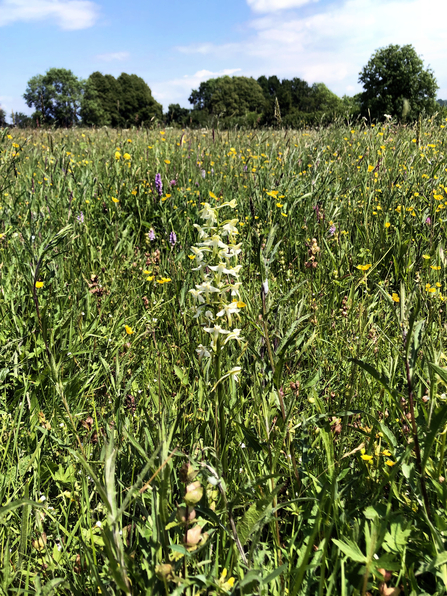Characterised by their incredible diversity of flora and fauna during the spring and summer months, meadows provide some of the most important habitats for local wildlife. The eclectic mosaic of plants attracts a plethora of small insects, birds, and mammals. However, due to years of intensive farming, wildflower meadows have been on the sharp decline in Wales.
Restoring these grasslands is a core restoration project for GWT, to ensure that threatened wildlife has a safe place to call home.
Why are Meadows Being Lost? And Why Restore Them?
Over two thirds of Wales is defined as grassland. Most of this, however, is "improved", meaning it has been reseeded, fertilised, or drained for livestock production. Farmers cultivate such an environment to ensure the growth of nutrient-rich grasses upon which their livestock can thrive.
Native British wildflowers, in contrast, prefer nutrient-deficient soils. The "unimproved", or semi-natural, grasslands in which you can find these species dominated much of the Welsh lowlands just a hundred years ago, but intensive farming practices have caused a massive 90% decline throughout the late 20th century. Now, these unimproved landscapes account for just 9% of the country’s land area.
By restoring improved grasslands to their natural, nutrient-deficient state, we can promote the growth of various plants and grasses that provide spaces for species whose numbers are threatened due to habitat destruction.
At a number of GWT reserves including Wyeswood Common, Pentwyn Farm and Bridewell Common, we use a variety of techniques that make meadows suitable habitats for both plant and animal species. We are already seeing wildlife return to these spaces thanks to such efforts. In this post, two such methods of meadow restoration are outlined.
Green Hay
Green hay is a term used to describe the grasses and flowers freshly cut from a wildflower meadow in the late summer months. It is not dried and baled, hence its colour, and it is rich in seeds from a plethora of wildflower species. By spreading green hay on a species-deficient site, we also spread these seeds where they germinate, aiding the restoration of the site by increasing the variety of its species.
Green hay, however, heats up quickly once it is harvested, which rapidly reduces the viability of the seeds it contains.
This makes green hay spreading a very selective process, as the green hay site must be close enough to be able to harvest, transport and spread the seeds the same day.
And it can only occur on a site that neighbours a pre-existing wildflower meadow. Thankfully, many of GWT’s recent restoration projects meet this standard.
Wyeswood Common is one such example that GWT is working hard to restore to a natural meadow. Acquired by the Wildlife Trust in January 2008, Wyeswood originally operated as a dairy farm and, as a result of the intensive farming that took place on the site, much of its wildflower population was lost. However, the reserve neighbours Pentwyn Farm nature reserve, an SSSI (Site of Special Scientific Interest) that boasts an incredible diversity of wildflowers and grasses, with over 80 species recorded. As a result, in the late summer months, GWT staff and volunteers cut green hay from Pentwyn Farm and spread it across the fields at Wyeswood Common. Thanks to these efforts, we have already started to see nature return to Wyeswood reserve. Sightings include birds like goldfinches, Skylarks and meadows are a fantastic feeding ground for Swifts throughout July and early August.
Conservation Grazing
Once the annual hay cut is complete, a meadow closely resembles a pasture, and this actually opens up another opportunity to aid the restoration process! As mentioned before, high-intensity livestock farming can lead to the destruction of habitats, however, at a lower intensity, grazers actually create the perfect conditions for a wide variety of species to thrive.
Unlike humans, animals rarely act in a monotonous and uniform manner. Thanks to the differences in their habits and behaviours, livestock stomp and snack their way, creating along the way a variety of small habitats that critters can call home.
To create an area so rich in natural diversity, conservation grazing uses a variety of livestock. This works because different animals feed in different ways. For example, cows wrap their tongues around the plants and pull them up, whilst sheep tend to nibble the vegetation to much shorter lengths. This variation in feeding patterns causes plants and grasses to grow at fluctuating heights, creating a range of environments that are suitable for diverse species.
In addition, livestock manure is actually a great source of nutrients for both plants and insects! This only further promotes the growth of flowers in the spring and summer once the grazers have been removed from the site.
A well-varied choice of livestock is very important for conservation grazing, but these animals must also be well suited to the environment, and kept at a low density. As a result, the selection of grazers must be carefully made. Since conservation grazing was implemented at Wyeswood Common, GWT has used a mix of Hebridean and Hill Radnor sheep, alongside Traditional Hereford and Longhorn Cattle. These are hardy breeds that graze well even on poor quality pasture, which is exactly what is needed when trying to restore a meadow environment.



